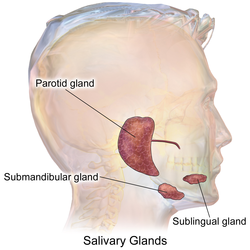| Salivary gland | |
|---|---|
 The three main paired salivary glands. | |
| Details | |
| System | Digestive system |
| Identifiers | |
| Latin | glandulae salivariae |
| MeSH | D012469 |
| TA98 | A05.1.02.002 A05.1.02.013 |
| TA2 | 2798 |
| FMA | 9597 95971, 9597 |
| Anatomical terminology | |
The salivary glands in many vertebrates including mammals are exocrine glands that produce saliva through a system of ducts. Humans have three paired major salivary glands (parotid, submandibular, and sublingual), as well as hundreds of minor salivary glands.[1] Salivary glands can be classified as serous, mucous, or seromucous (mixed).
In serous secretions, the main type of protein secreted is alpha-amylase, an enzyme that breaks down starch into maltose and glucose,[2] whereas in mucous secretions, the main protein secreted is mucin, which acts as a lubricant.[1]
In humans, 1200 to 1500 ml of saliva are produced every day.[3] The secretion of saliva (salivation) is mediated by parasympathetic stimulation; acetylcholine is the active neurotransmitter and binds to muscarinic receptors in the glands, leading to increased salivation.[3][4]
A proposed fourth pair of salivary glands, the tubarial glands, were first identified in 2020. They are named for their location, being positioned in front of and over the torus tubarius. However, this finding from one study is yet to be confirmed.[5]
- ^ a b Edgar, Michael; Dawes, Colin; O'Mullane, Denis, eds. (2012). Saliva and oral health (4th ed.). Stephen Hancocks. p. 1. ISBN 978-0-9565668-3-6.
- ^ Martini, Frederic H.; Nath, Judi L.; Bartholomew, Edwin (2012). Fundamentals of anatomy & physiology (9th ed.). Pearson Benjamin Cummings. ISBN 9780321709332.
- ^ a b James, Eleanor; Ellis, Cathy; Brassington, Ruth; Sathasivam, Sivakumar; Young, Carolyn A. (2022-05-20). "Treatment for sialorrhea (excessive saliva) in people with motor neuron disease/amyotrophic lateral sclerosis". The Cochrane Database of Systematic Reviews. 2022 (5): CD006981. doi:10.1002/14651858.CD006981.pub3. ISSN 1469-493X. PMC 9121913. PMID 35593746.
- ^ Davies, Andrew N; Thompson, Jo (2015-10-05). "Parasympathomimetic drugs for the treatment of salivary gland dysfunction due to radiotherapy". Cochrane Database of Systematic Reviews. 2020 (10): CD003782. doi:10.1002/14651858.CD003782.pub3. PMC 6599847. PMID 26436597.
- ^ Wu, Katherine J. (2020-10-19). "Doctors May Have Found Secretive New Organs in the Center of Your Head". The New York Times. Retrieved 2020-10-22.